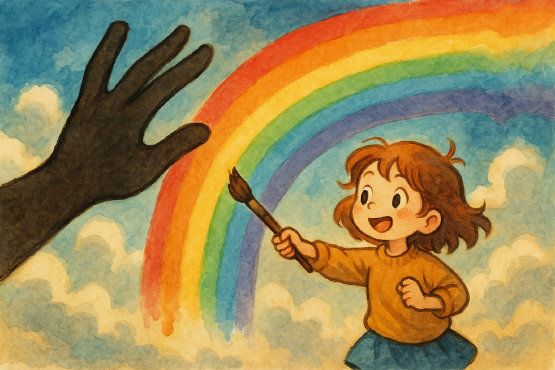A hand trying to erase the rainbow, gazing beyond it
Rainbows and the Landscape of Society
The landscape of society we face today is at a point where a variety of possibilities and deep fractures intersect more than ever. Technology has advanced rapidly, and information flows in real-time, yet the spaces we share are increasingly disappearing. The successive closures of universities and cultural spaces, which formed the intellectual and cultural heart of our society, symbolize not just the loss of buildings but also a disturbance in our values and sense of community. This reveals that the fundamental values our society must uphold—free expression, respect for diversity, and the rights of minorities—are structurally threatened. This writing is not merely an elegy for the loss of space it proposes a voice for deep reflection on the social dilemmas brought about by this loss and the direction we need to take.
The Symbolism of Space and the Ripple Effects of Its Loss
Universities are not simply places to learn. They are where the conscience of the era resides, serving as a public forum where different voices clash and reconcile. The narratives of resistance against discrimination and hatred have grown in this space, as many individuals have proudly expressed their own identities, gradually breaking down the walls of society. However, now these spaces are closing one by one, and a shadow of silence is falling over them. This reflects the contraction of intellect and the stifling of freedom of expression. When universities are silent, society stops thinking. And in that void, hatred and indifference take hold. The same applies to cultural and artistic spaces. Art is both a mirror reflecting society and a window that sometimes allows us to imagine beyond the mirror. However, right now, that window is gradually closing. Freedom of expression is precariously shaken in front of the blade of censorship, and creators are becoming fearful of even voicing their thoughts. As a result, society is losing sensitivity towards 'otherness' and regressing into a landscape that only imposes uniformity and conformity.
Dignity and coexistence, the precarious boundary
Today, the most threatened is 'the person' itself. In particular, the dignity of minorities such as sexual minorities still stands in front of the wall of hate and discrimination. A society that cannot welcome those who want to speak out and considers their very existence as discomfort cannot be healthy. When we fail to accept other beings, society inevitably builds walls of silence. That silence blocks conversation, hinders solidarity, and ultimately leads to the collapse of the community. A society that excludes diversity is draining its own vitality and is nothing more than a self-destructive structure that blocks the possibilities of progress and creativity.
University, questioning the weight of its name again
In the past, universities were spaces that questioned the era, drove society, and opened possibilities for new thinking. However, now, that light is dimming. Is true scholarship possible in places infiltrated by censorship and oppression? The most fundamental question about what kind of society we dream of begins right at this point. A campus where critique and inquiry have vanished can no longer be called a 'university.' We must contemplate what kind of world we will leave for future generations. They possess more voices and colors than we do. Providing a space that does not suppress those voices and erase those colors should be the true starting point of education.
The most urgent task called 'coexistence'
Coexistence is not simply about existing together. It stems from the attitude of recognizing each other as we are and viewing differences with respect rather than discrimination. What we need most right now is the courage to stand against hatred. That courage does not come from grand declarations, but begins with small actions that listen to the voices of our neighbors in our daily lives. When the silence of respect resonates deeper than the words of hatred, we find ourselves at the threshold of true coexistence. And what is needed to cross that threshold is not technology or systems, but our own humanity.
A rainbow cannot be erased.
A rainbow is not made up of a single color it is only complete when different colors stand side by side. Society is just the same. When people with different identities and thoughts come together, we can finally achieve beautiful harmony. If someone tries to erase one color of the rainbow, in the end, the rainbow will collapse, and that hand will wipe away the face of us all. To protect the rainbow, we must speak up. We must take action. And above all, we must embrace each other.
Now, we must start from here.
The value of coexistence does not stem from an ideal of a distant future, but rather from our individual choices made in this very moment. When small and quiet voices come together to create a tremendous resonance, and that resonance breaks down the walls of silence, we can move closer to a warmer society. Beyond discrimination and hatred, a society where everyone lives with dignity. That is the path we must take and the most precious legacy we should leave in this era.

Post a Comment